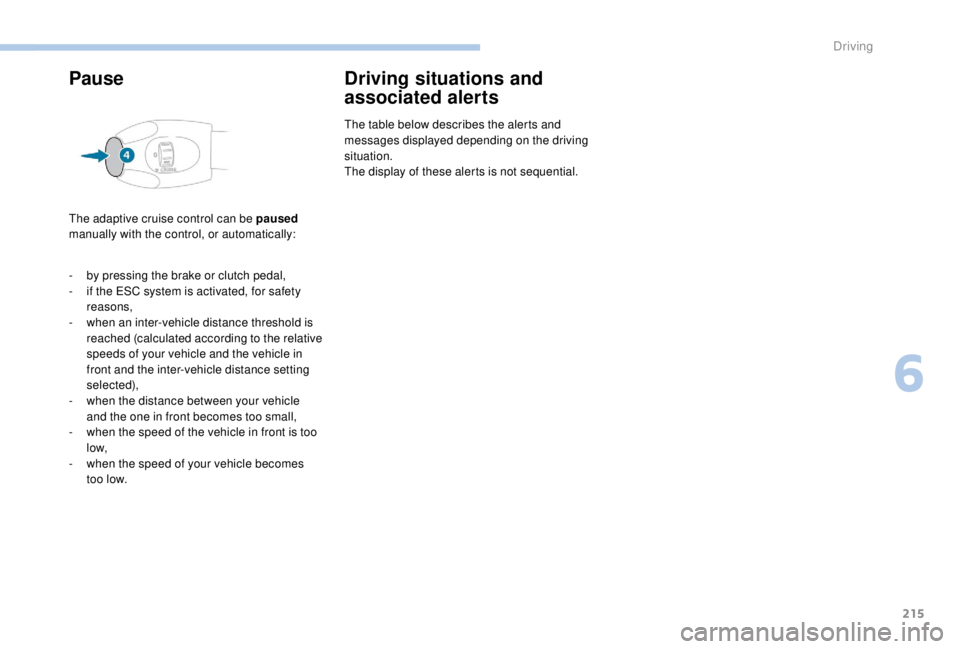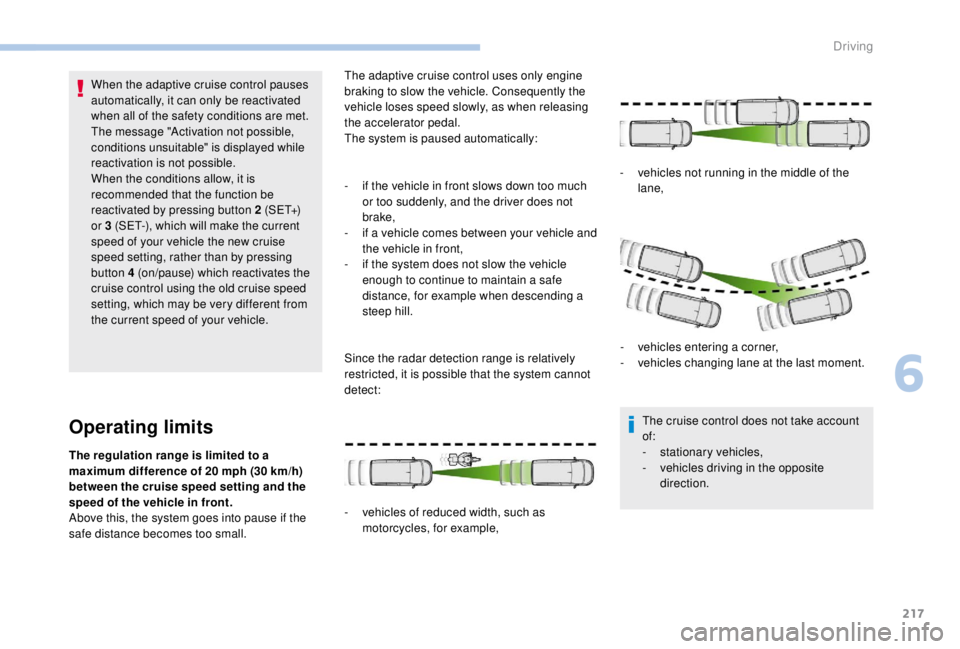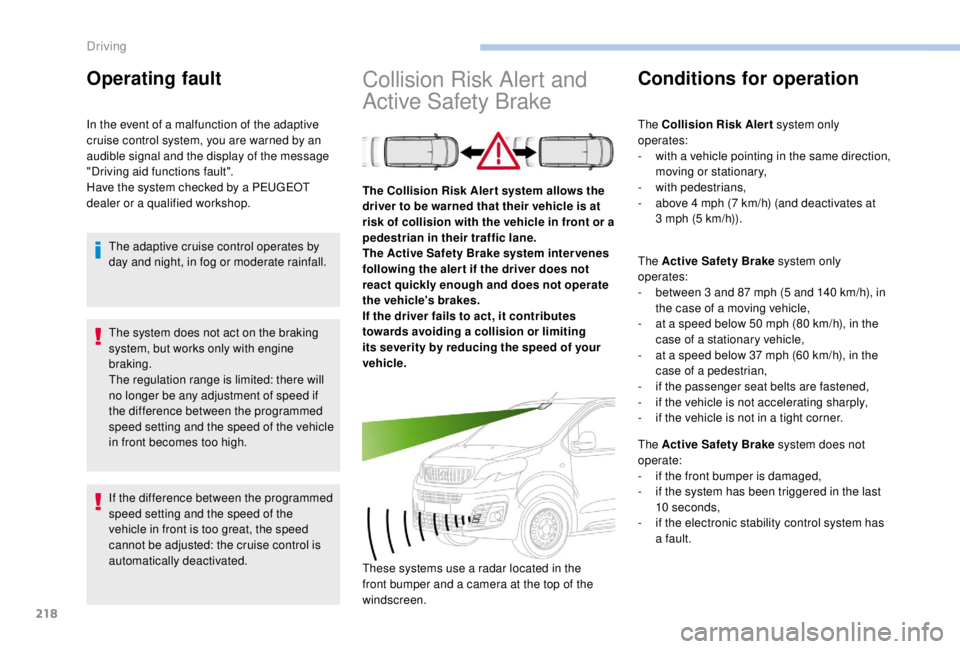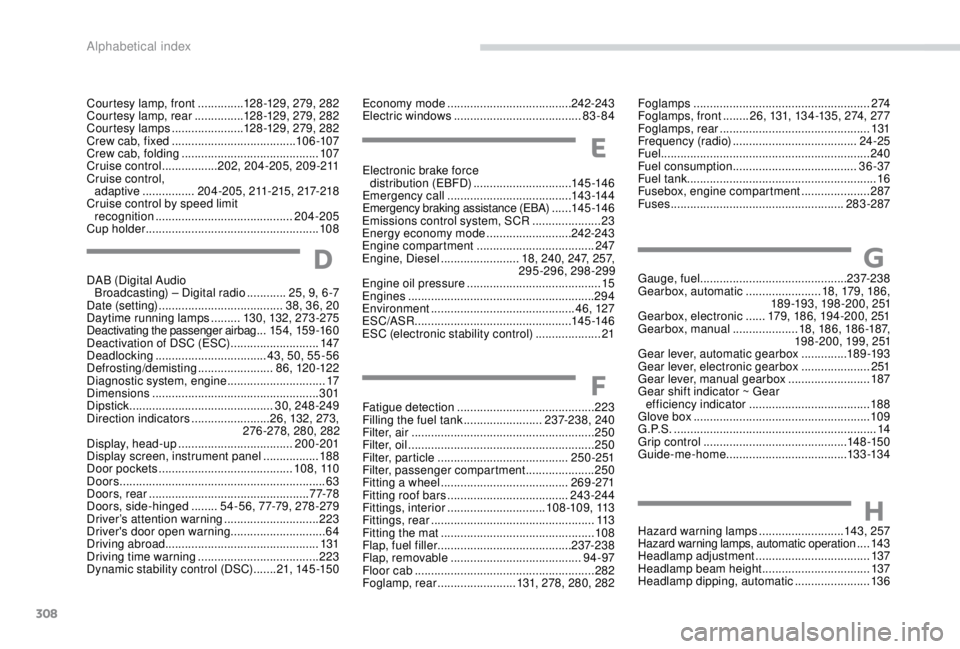2018 PEUGEOT EXPERT cruise control
[x] Cancel search: cruise controlPage 214 of 416

212
Steering mounted controls
1.Selects cruise control mode.
2. Programme a speed/Decrease the value.
3. Programme a speed/Increase the value.
4. Pause/resume cruise control.
5. If fitted to your vehicle, display the list
of memorised speeds or memorise the
speed suggested by the speed limit
recognition system.
6. Select the inter-vehicle distance (" Close",
" Normal ", "Distant ").
Display on the instrument panel
Head-up display
7.Cruise control pause/resume indication.
8. Indication of selection of cruise control
mode, or vehicle speed adjustment
phase.
9. Value of the speed setting. For more information on the Head-up
display
, refer to the corresponding
section.
Switching on
The adaptive cruise control is switched on
manually, it requires that the speed of the
vehicle be between 25
mph and 90 mph
(40
km/h and 150 km/h).
If the cruise speed setting is above
90
mph (150 km/h), the adaptive cruise
control switches to normal cruise control
mode (without automatic regulation of the
safe inter-vehicle distance).
With a manual gearbox, third or fourth gear or
higher must be engaged.
With an automatic or electronic gearbox,
second gear or higher must be engaged.
For more information on the Cruise
control , refer to the corresponding
section.
By default, the inter-vehicle distance is set
at "
Normal ".
Other wise, the last setting made will be
used when switching on the system.
Driving
Page 215 of 416

213
The adaptive cruise control must be selected in
the "Driving/Vehicle " menu.
Changing the cruise speed
yourself
F Turn thumbwheel 1 to the "CRUISE "
position: the cruise control mode is selected
but is not switched on (Pause).
F
P
ress one of the buttons 2 or 3: the current
speed of your vehicle becomes the cruise
speed setting.
The cruise control is activated (ON).
If the cruise control is on, you can then change
the initial speed:
-
u
sing buttons 2 or 3:
F
b
y successive short presses, to modify by
steps of + or - 1
mph (km/h),
F
b
y a maintained press, to change in steps
of + or - 5
mph (km/h). For more information on
Speed limit recognition
and
memorising them in particular,
refer to the corresponding
section.
As a precaution, it is recommended that
you select a cruise speed setting close to
the current speed of your vehicle.
-
b
y pressing button 5
, if your vehicle has
speed memorisation:
F t he six speeds memorised are displayed
in the touch screen,
F
c
hoose a speed setting: it is displayed on
the instrument panel.
The selection screen closes after a few
moments.
The change then takes effect. -
b y pressing button 5
, if your vehicle is
equipped with speed limit recognition:
F
t
he speed to memorise is displayed in the
instrument panel,
F
press button 5
again to save the speed.
The value appears immediately on the
instrument panel.
6
Driving
Page 216 of 416

214
Inter-vehicle distance Changing the inter-vehicle distance
This value remains in memory, regardless of
the state of the system.
In the event of the presence of a vehicle
detected by the inter-vehicle distance
radar, if the speed selected is too far
above the speed of that vehicle, the
system is not activated and the alert
message "Activation not possible,
conditions unsuitable" is displayed until
driving conditions are safe to allow
activation of the system.
The inter-vehicle distance setting is
memorised when the ignition is switched
of f.
Exceeding programmed
speed
Using radar with a range of about 100 metres,
l ocated at the front of the vehicle, this system
detects a vehicle travelling in front of your
vehicle.
It automatically adjusts the speed of your
vehicle to that of the vehicle in front.
If the vehicle in front is running more slowly,
the system progressively reduces the speed of
your vehicle using just engine braking (as if the
driver had pressed the " -" b u t to n).
If your vehicle is too close to the vehicle in
front or is approaching it too quickly, adaptive
cruise control is automatically deactivated.
The driver is then alerted by an audible signal
accompanied by a message.
If the vehicle in front accelerates or changes
lane, the adaptive cruise control gradually
accelerates your vehicle to return to the
programmed speed.
If the driver operates a direction indicator to
overtake a slower vehicle, the adaptive cruise
control allows your vehicle to temporarily
approach the vehicle in front to assist the
overtaking manoeuvre, though never exceeding
the programmed speed. F
P
ress button 6 to select a new inter-vehicle
distance setting from the 3
levels ("Close",
" Normal ", "Distant "). It is possible to exceed the
programmed speed temporarily by
depressing the accelerator pedal.
Simply release the accelerator pedal
to return to the programmed speed.
If the programmed setting is unintentionally
exceeded, descending a steep hill for example,
the speed setting in the instrument panel
flashes as a warning.
Driving
Page 217 of 416

215
Pause
The adaptive cruise control can be paused
manually with the control, or automatically:
Driving situations and
associated alerts
The table below describes the alerts and
messages displayed depending on the driving
situation.
The display of these alerts is not sequential.
-
b
y pressing the brake or clutch pedal,
-
i
f the ESC system is activated, for safety
reasons,
-
w
hen an inter-vehicle distance threshold is
reached (calculated according to the relative
speeds of your vehicle and the vehicle in
front and the inter-vehicle distance setting
selected),
-
w
hen the distance between your vehicle
and the one in front becomes too small,
-
w
hen the speed of the vehicle in front is too
low,
-
w
hen the speed of your vehicle becomes
too low.
6
Driving
Page 218 of 416

216
SymbolAssociated message Comment
No vehicle detected: the system operates as a standard cruise control.
Detection of a vehicle, at the limit of the range of the radar: the system operates as a
standard cruise control.
"SPEED ADJUSTED" Detection of a vehicle that is too close or running at a speed lower than your vehicle's
cruise speed setting.
The system uses engine braking to slow your vehicle (within a limit of 20
mph (30 km/h))
and then keeps it at the speed of the vehicle in front so as to obser ve the programmed
inter-vehicle time.
When automatically slowing down behind a vehicle, your true speed may be higher than
the "adjusted speed" displayed.
"SPEED ADJUSTED" When the adjusted speed reaches the limit of regulation (speed setting – 20
mph
(30
km/h)), the adjusted speed flashes together with the speed setting to signal that
automatic deactivation of the system is imminent.
"Cruise control paused". If the system exceeds the limit of speed adjustment that it can make and in the absence of
any reaction by the driver (operation of the direction indicator, change of lane, reduction in
the speed of the vehicle), the system is automatically paused.
The display of the deactivation message is accompanied by an audible signal.
Driving
Page 219 of 416

217
When the adaptive cruise control pauses
automatically, it can only be reactivated
when all of the safety conditions are met.
The message "Activation not possible,
conditions unsuitable" is displayed while
reactivation is not possible.
When the conditions allow, it is
recommended that the function be
reactivated by pressing button 2 ( S E T+)
or 3
(SET-), which will make the current
speed of your vehicle the new cruise
speed setting, rather than by pressing
button 4
(on/pause) which reactivates the
cruise control using the old cruise speed
setting, which may be very different from
the current speed of your vehicle.
Operating limits
The regulation range is limited to a
maximum difference of 20 mph (30 km/h)
between the cruise speed setting and the
speed of the vehicle in front.
Above this, the system goes into pause if the
safe distance becomes too small. -
i
f the vehicle in front slows down too much
or too suddenly, and the driver does not
brake,
-
i
f a vehicle comes between your vehicle and
the vehicle in front,
-
i
f the system does not slow the vehicle
enough to continue to maintain a safe
distance, for example when descending a
steep hill.
Since the radar detection range is relatively
restricted, it is possible that the system cannot
detect:
-
v
ehicles of reduced width, such as
motorcycles, for example, -
v
ehicles not running in the middle of the
lane,
-
v
ehicles entering a corner,
-
v
ehicles changing lane at the last moment.
The cruise control does not take account
of:
- s tationary vehicles,
- v ehicles driving in the opposite
direction.
The adaptive cruise control uses only engine
braking to slow the vehicle. Consequently the
vehicle loses speed slowly, as when releasing
the accelerator pedal.
The system is paused automatically:
6
Driving
Page 220 of 416

218
The system does not act on the braking
system, but works only with engine
braking.
The regulation range is limited: there will
no longer be any adjustment of speed if
the difference between the programmed
speed setting and the speed of the vehicle
in front becomes too high.
If the difference between the programmed
speed setting and the speed of the
vehicle in front is too great, the speed
cannot be adjusted: the cruise control is
automatically deactivated.
Collision Risk Alert and
Active Safety BrakeConditions for operation
The Collision Risk Alert system only
operates:
-
w
ith a vehicle pointing in the same direction,
moving or stationary,
-
w
ith pedestrians,
-
a
bove 4 mph (7 km/h) (and deactivates at
3
mph (5 km/h)).
The Active Safety Brake system only
operates:
-
b
etween 3 and 87 mph (5 and 140 km/h), in
the case of a moving vehicle,
-
a
t a speed below 50 mph (80 km/h), in the
case of a stationary vehicle,
-
a
t a speed below 37 mph (60 km/h), in the
case of a pedestrian,
-
i
f the passenger seat belts are fastened,
-
i
f the vehicle is not accelerating sharply,
-
i
f the vehicle is not in a tight corner.
The Active Safety Brake system does not
operate:
-
i
f the front bumper is damaged,
-
i
f the system has been triggered in the last
10
seconds,
-
i
f the electronic stability control system has
a fault.
The Collision Risk Aler t system allows the
driver to be warned that their vehicle is at
risk of collision with the vehicle in front or a
pedestrian in their traffic lane.
The Active Safety Brake system inter venes
following the aler t if the driver does not
react quickly enough and does not operate
the vehicle's brakes.
If the driver fails to act, it contributes
towards avoiding a collision or limiting
its severity by reducing the speed of your
vehicle.
These systems use a radar located in the
front bumper and a camera at the top of the
windscreen.
Operating fault
In the event of a malfunction of the adaptive
cruise control system, you are warned by an
audible signal and the display of the message
"Driving aid functions fault".
Have the system checked by a PEUGEOT
dealer or a qualified workshop.
The adaptive cruise control operates by
day and night, in fog or moderate rainfall.
Driving
Page 406 of 416

308
G
H
Gauge, fuel............................................. 237-238
Gearbox, automatic .......................18, 179, 186,
189 -193, 198 -20 0, 251
Gearbox, electronic
......179, 186, 194-200, 251
Gearbox, manual
....................18, 18 6, 18 6 -187,
198 -20 0, 19 9, 251
Gear lever, automatic gearbox
..............18 9 -19 3
Gear lever, electronic gearbox
.....................2 51
Gear lever, manual gearbox
.........................187
Gear shift indicator ~ Gear efficiency indicator
..................................... 188
Glove box
...................................................... 109
G . P. S .
.............................................................. 14
Grip control
............................................ 14 8 -15 0
Guide-me-home
..................................... 13 3 -13 4
Hazard warning lamps
..........................143, 257
Hazard warning lamps, automatic operation
....143
Headlamp adjustment
...................................137
Headlamp beam height
................................. 13
7
Headlamp dipping, automatic
.......................13 6
Electronic brake force
distribution (EBFD)
.............................. 14
5 -14 6
Emergency call
......................................
143 -14 4
Emergency braking assistance (EBA)
...... 14
5 -14 6
Emissions control system, SCR
.....................
23
Energy economy mode
.......................... 24
2-243
Engine compartment
.................................... 2
47
Engine, Diesel
........................
18, 240, 247, 257,
295-296, 298-299
Engine oil pressure
......................................... 15
Engines
......................................................... 294
Environment
............................................ 4 6, 127
ESC/ASR
................................................145 -14 6
ESC (electronic stability control)
.................... 21
E
F
Fatigue detection .......................................... 223
Filling the fuel tank ........................237-238, 240
Filter, air
........................................................ 250
Filter, oil
................
......................................... 250
Filter, particle
........................................ 250-251
Filter, passenger compartment
.....................250
Fitting a wheel
....................................... 2 6 9 -271
Fitting roof bars
..................................... 243 -244
Fittings, interior
.............................. 10
8 -109, 113
Fittings, rear
.................................................. 113
Fitting the mat
............................................... 108
Flap, fuel filler
......................................... 237-238
Flap, removable
..............................
..........94-97
Floor cab
....................................................... 282
Foglamp, rear
........................ 131, 278, 280, 282
DDAB (Digital Audio
Broadcasting) – Digital radio ............25, 9, 6 -7
Date (setting)
...................................... 38, 36, 20
Daytime running lamps
.........13 0, 132, 273 -275
Deactivating the passenger airbag ...154, 159 -16 0
Deactivation of DSC (ESC)
........................... 147
Deadlocking
.................................. 43, 50, 55 -56
Defrosting/demisting
....................... 8 6, 120 -12 2
Diagnostic system, engine
.............................. 17
D
imensions
..............................
..................... 301
Dipstick
................
............................ 30, 248-249
Direction indicators
........................ 26, 132, 273,
276 -278, 280, 282
Display, head-up
...............................
....200-201
Display screen, instrument panel
................. 188
Door pockets
...............................
.......... 108, 110
Doors
............................................................... 63
Doors, rear
................................................. 7 7-78
Doors, side-hinged
........ 5
4-56, 77-79, 278-279
Driver’s attention warning
............................. 223
Driver's door open warning
............................. 64
Driving abroad ............................................... 131
Driving time warning
..................................... 223
Dynamic stability control (DSC)
....... 21, 14 5 -15 0
Courtesy lamp, front
..............
128 -12 9, 279, 282
Courtesy lamp, rear
...............
128 -12 9, 279, 282
Courtesy lamps
......................
128 -12 9, 279, 282
Crew cab, fixed
......................................
10 6 -107
Crew cab, folding
..........................................
107
Cruise control
.................
202, 204-205, 209-211
Cruise control, adaptive
................
204 -205, 211-215, 217-218
Cruise control by speed limit recognition
...............................
...........
204-205
Cup holder
.....................................................
108Economy mode
......................................
24
2-243
Electric windows
.......................................
83-84Foglamps
......................................................
2 74
Foglamps, front
........
26, 131, 134-135, 274, 277
Foglamps, rear
.............................................. 13
1
Frequency (radio)
......................................
24-25
Fuel ................................................................ 240
Fuel consumption
......................................
36 -37
Fuel tank .......................................................... 16
Fusebox, engine compartment
.....................
287
Fuses
..................................................... 28
3-287
Alphabetical index